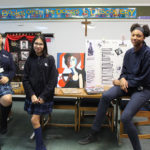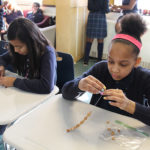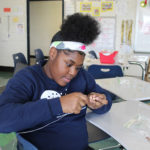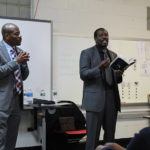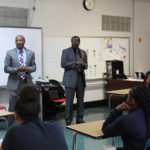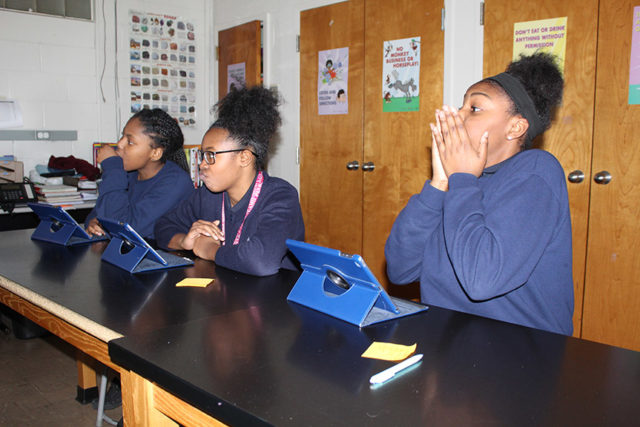
NEW CASTLE — February is a special month at Serviam Girls Academy. The students at the New Castle School — many of whom are African American or Latino — always find a unique way to celebrate Black History Month, and this year was no different.
On Feb. 21, the 61 students laughed, listened and presented the latest of their annual projects.
In one of the classrooms, Delaware’s poets laureate used the spoken word to teach the girls about dreams and ambition. State Rep. Nnamdi Chukwuocha and his twin brother, Al Mills, known as the Twin Poets, held the youngsters’ attention with their rapid-fire, introspective verses.
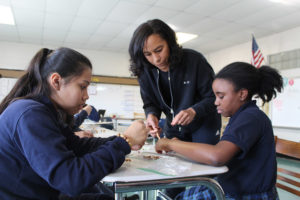
With titles like “Dreams Are Not Illegal” and “Goals,” the men talked about getting organized and finding success. They asked who likes poetry, and when one student said she did not, they wanted to know why. When she told them that her favorite rapper was Drake, the poets saw an opportunity.
“Poetry is in the music,” Chukwuocha told the class. “That’s the way they express themselves.”
In another room, groups of girls took turns playing “Kahoot,” an online trivia game in which they used tablets to answer dozens of questions about prominent African Americans.
Down the hall, the students made bracelets using various beads. Serviam principal Altina Herbert said each of the beads means something different in African culture, so it fit in with their social studies curriculum.
Eighth-grader Misty Osborne said making the bracelet meant a lot to her.
“Each African bead has a symbolization. Certain ones don’t. They’re just very pretty. For example, the flower one symbolizes peace and beauty in their land. We’re just trying to make bracelets and represent our culture,” she said.
Each of the students also created a presentation on a public figure, and the gallery of those presentations was open for everyone to see. Herbert said the girls embraced the project.
“We embrace it, one because of our culture here, and two, our students have embodied this. This year’s theme is ‘Because of them, we can,’” she said.
“Students have embodied thinking about African Americans, Latinos or African-Latino mix – because we have families that intermix – they found these people and really got to know who they were and see how they could see themselves in that and could strive to see themselves do that later on in life.”
Jazzlyn Wesley, an eighth-grade student, chose the late actress and singer Eartha Kitt as her public figure. She said he had worked on a project on Kitt when she was in third grade, but it was never displayed at her school. This time, it was front and center. Kitt, she said, had qualities worth admiring.
“I think she’s very, very confident in herself, and she is a really good actor. And she sang in different languages. I thought that was pretty cool,” Wesley said.
She continued that the people she and the other students wrote about helped make opportunities available for today’s youth, and that needs to be remembered.
“We have to learn about the people that actually helped us get here today. They just have to be acknowledged for all their great work and the dignity and pride they put into the community,” Jazzlyn said.
Her classmate, Yaline Colon, went with singer Ella Fitzgerald “because she’s not as well-known as she should be. I think it’s important for people to know about her.”
Fitzgerald, who died in 1996, was the first African American woman to win a Grammy, in 1959 at the inaugural awards show. She had 13 in her lifetime.
A third eighth-grader, Yaneiri Alvarado, researched Faith Ringgold, an artist and much more.
“She’s a civil rights activist and an author,” Yaneiri said. “She kind of started her art in her early years in high school. It really inspired me that most of her art had really deep meaning because mixes the civil rights and the painting together.”
She added that she liked that the projects required more in-depth work that the typical schoolwork.
“You can’t be like, this is their birthday, and that’s it. You have to find out who inspired them, how did their careers start. You really have to dig deep,” she said.
Yaline, in her fourth year at Serviam, likes how the school does something different each year for Black History Month.
“We always do something new, and it’s cool to see everybody’s artistic side come out. It’s also the history as well,” she said.
Seventh-grader Aiyanna appreciates that her school values her history and culture. “It means a lot because I’m African. I embrace my culture a lot. For me to be able to celebrate it with other people means a lot.”






